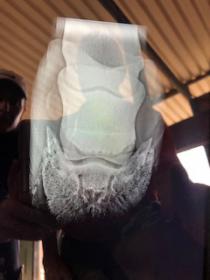I just completed a PPE on a 12 year old warmblood that I am considering buying. This horse has been competitive as a 1.10 meter horse, and I’m looking at him as all around amateur horse for light showing. He probably won’t jump much higher than 3 feet very often. This horse is pretty perfect except for the xrays. Kind, patient, would be an excellent teacher. Super easy and a love bug! He flexed positive on his right front. He was sound on hard ground, and actually moved better on hard than soft ground. Vet xrayed legs and feet. Joints looked better than expected, but the navicular xrays showed moderate changes. He’s been with me on trial and sound and steady under saddle so far. The flexion was a bit surprising considering the degree of sensitivity he showed. I’m torn on whether to move forward or not. I owned a QH with navicular as a kid 30 years ago and it was devastating, so I was inclined to run away when first seeing the xrays. Now I’m being told it’s less of an issue in Warmbloods and there’s many more treatments available to keep them going longer. I’m interested in getting current thoughts on this. I don’t have previous xrays for comparison. Thanks!

